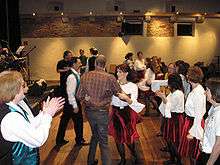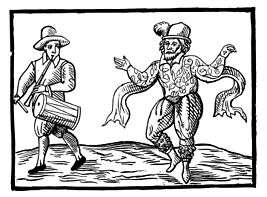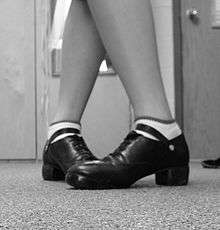Jig
The jig (Irish: port, Scottish Gaelic: port-cruinn) is a form of lively folk dance in compound metre, as well as the accompanying dance tune. It developed in 16th-century England, and was quickly adopted on mainland Europe where it eventually became the final movement of the mature Baroque dance suite (the French gigue; Italian and Spanish giga).[1] Today it is most associated with Irish dance music, Scottish country dance and the Métis people in Canada.[2] Jigs were originally in duple compound metre, (e.g., 12
8 time), but have been adapted to a variety of time signatures, by which they are often classified into groups, including light jigs, slip jigs, single jigs, double jigs, and treble jigs.

Origins

The term jig was probably derived from the French giguer, meaning 'to jump' or the Italian giga.[3] The use of "jig" in Irish dance derives from the Irish jigeánnai, itself borrowed from the Old English giga meaning "old dance".[4] It was known as a dance in 16th-century England, often in 12
8 time,[5] and the term was used for a post-play entertainment featuring dance in early modern England, but which 'probably employed a great variety
of dances, solo (suitable for jigs), paired, round, country or courtly':[6] in Playford's Dancing Master (1651) 'the dance game in ‘Kemps Jegg’ is a typical scenario from a dramatic jig and it is likely that the combination of dance metre for steps and non-metrical passages for pantomime indicates how a solo or ensemble jig might have been danced by stage players.'[7] Later the dance began to be associated with music particularly in 6
8 time, and with slip jigs 9
8 time.[8]
Ireland and Scotland
During the seventeenth century the dance was adopted in Ireland and Scotland, where it was widely adapted, and the jig is now most often associated with these countries.[9] The jig is second in popularity only to the reel in traditional Irish dance; it is popular but somewhat less common in Scottish country dance music. It is transcribed in compound metre, being 6
8 time. The most common structure of a jig is two eight-bar parts, performing two different steps, each once on the right foot, and one on the left foot. As with most other types of dance tunes in Irish music, at a session or a dance it is common for two or more jigs to be strung together in a set, flowing on without interruption.
In Irish step dance
Light jigs

A light jig is the second-fastest of all the jigs. The performer's feet rarely leave the ground for long, as the step is fast, typically performed at a speed around 116 at feiseanna. There are several light jig steps, varying with each dance school, but one step is almost standard in all light jigs. This step is known as the rising step, or the rise and grind. This is the right side version of it: Put your weight on your left foot and lift your right foot off the ground. Hop on your left foot once. Hop on your left foot again, bringing your right foot back behind your left foot and then shift your weight onto your right foot, leaving your left foot in the air. Dancers use the phrase "hop, hop back" for these three movements, and there is a slight pause between the hop, and hop back. The next movement is a hop on your right foot. Then you shift your weight on your feet, left-right-left-right. The phrase for this whole movement is: "hop, hop back, hop back 2-3-4." To do the step on the left foot, reverse the left and right directions.[10]
Slip jigs
Slip jigs are in 9
8 time. Because of the longer measures, they are longer than the reel and the light jig, with the same number of bars to the music.[11] The dance is performed high on the toes, and is often considered the "ballet of Irish dance" because of its graceful movements that seem to slip the performers across the floor. Slip jigs are performed at a speed of 113 at feiseanna.
Single and double jigs
Single jigs should not be confused with slides; they are the least common of the jigs, performed in ghillies, in a 6
8 or less commonly a 12
8 time. Musically, the single jig tends to follow the pattern of a quarter note followed by an eighth note (twice per 6
8 bar), whereas the pattern for the double jig is three eighth notes twice per 6
8 bar.
Hop jigs
Hop jigs are the fastest of all jigs next to light jigs, but the term hop jig causes some confusion, as some people use it for a single jig, while others use this term to refer to a tune in 9
8 time.
Among the latter, some do not distinguish it from a slip jig, while some reserve the term to a slip jig variant that has special characteristics, in particular an emphasis on 1/4–1/8 pairs.
Treble jigs
Treble jigs (also called the hard or heavy jig) are performed in hard shoes, and also to a 6
8 time metre. They are characterized by stomps, trebles, and clicks. Many set dances are performed in treble jig time, a few being Drunken Gauger, Blackthorn Stick, The Three Sea Captains, and St Patrick's Day. Two types of treble jigs are performed at feiseanna: the traditional and non-traditional (slow) treble jigs. Beginners will do a treble jig at traditional speed (92 bpm), while more advanced dancers will dance the non-traditional (slow) treble jig at 72 bpm.
Straight and sand jigs
In 19th-century America, the jig was the name adopted for a form of step dancing developed by enslaved African-Americans and later adopted by minstrel show performers. Danced to five-string banjo or fiddle tunes in 2
2 or 2
4 metre played at schottische tempo, the minstrel jig (also called the "straight jig" to distinguish it from Irish dances) was characterized by syncopated rhythm and eccentric movements. Jig dancers employed a repertoire of "hits" on the heel or toe, ""hops" on one foot, "springs" off both feet as well as various slides and shuffles.[12] The most famous early jig dancer was Master Juba, an African-American who inspired a host of white imitators, many of whom performed in blackface. John Diamond, an Irish-American who competed with Master Juba in a series of "challenge dances," was among the most prominent of these white minstrel jig dancers. Minstrel jigs, as well as clogs and breakdowns, were crucial to the evolution of 20th-century tap and soft-shoe dancing.
A variant of the straight jig was the "sand jig" or "sand dance," performed as a series of shuffles and slides on a sand-strewn stage. The most prominent sand jiggers of the19th century were two women, both born in New York in 1855: Buffalo native Kitty O'Neil and her Manhattan-born rival Kitty Sharpe.[13] Sand dancing was a staple of minstrelsy, variety and vaudeville, and was kept alive in later decades largely by African-American tap dancers, including John Bubbles, Bill "Bojangles" Robinson, Sammy Davis, Jr., Harriet Browne and, most prominently, Howard "Sandman" Sims.
See also
References
Notes
- Randel, edited by Don Michael (2003). The Harvard dictionary of music (4th ed.). Cambridge, MA: Belknap Press of Harvard University Press. pp. 421, 430. ISBN 9780674011632.CS1 maint: extra text: authors list (link)
- Driscoll, Michael; Hamilton, Meredith; Coons, Marie (May 2003). A Child's Introduction to Poetry. 151 West 19th Street New York, NY 10011: Black Dog & Leventhal Publishers. p. 12. ISBN 1-57912-282-5.CS1 maint: location (link)
- Ling, J.; Schenck, L. & R., A History of European Folk Music. Woodbridge: Boydell & Brewer, 1997, p. 194.
- Lyons, Reneé Critcher (2012). The revival of banned dances: a worldwide study. Jefferson, NC: McFarland & Company, Inc. p. 161. ISBN 9780786465941.
- Wilson, C. R. & Calore, M., Music in Shakespeare: a dictionary (Continuum International, 2005), p. 233.
- Clegg & Skeaping 2014, p. 10.
- Clegg & Skeaping 2014, p. 8.
- Casey, Marion; Lee, J. J. (2007). Making the Irish American: History and Heritage of the Irish in the United States. NYU Press. p. 418. ISBN 9780814752180.
- Raven, Michael, ed. (1999). One thousand English country dance tunes (2nd ed.). Market Drayton: Michael Raven. ISBN 9780906114315.
- Machaffie, Scott (5 November 1999). "Footwork for Irish and Scottish dancing". NonVi. Retrieved 4 November 2017.
- Cowdery, James R. (1990). The melodic tradition of Ireland. Kent, Ohio: Kent State Univ. Press. p. 17. ISBN 0-87338-407-5.
- James, ed. (1873). Jig, Clog and Breakdown Dancing Made Easy. New York. Retrieved 4 November 2017.
- Meade, Don (September 2014). "Kitty O'Neil and Her 'Champion Jig': A Forgotten Irish-American Variety Theater Star" (PDF). Retrieved 4 November 2017.
Bibliography
- Baskervill, Charles Read (1929). The Elizabethan jig and related song drama. Chicago: The University of Chicago Press.
- Brissenden, Alan (1981). Shakespeare and the dance. London: Macmillan. ISBN 978-0-333-28523-7.
- Clegg, Roger; Skeaping, Lucie (2014). Singing Simpkin and Other Bawdy Jigs: Musical Comedy on the Shakespearean Stage : Scripts, Music and Context. University of Exeter Press. ISBN 9780859898782.CS1 maint: ref=harv (link)
- Cullinane, John (2001). Further aspects of the history of Irish dancing in Ireland, Scotland, Canada, America, New Zealand and Australia (2nd ed.). Cork: John Cullinane. ISBN 0952795256.CS1 maint: ref=harv (link)